If you are worried about updating your WordPress website, you are not alone. Many beginners tell us they are concerned that an update might cause problems to their website.
However, after working with WordPress for so many years, we are convinced that keeping your website software updated is essential for maximizing website security and performance.
Using the latest version of WordPress means that your site benefits from the newest features, security patches, and improvements. An outdated version exposes your site to risk and misses out on improvements to your site’s speed and functionality.
In this beginner’s guide, we will show you how to update WordPress safely, allowing you to manage the process confidently without the fear of causing any issues. You will learn how to update your WordPress site like a pro while ensuring it remains secure and fully functional.
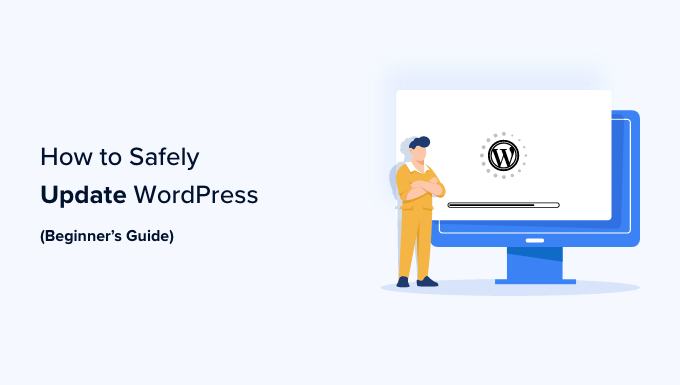
Upgrading your WordPress website is a regular maintenance task. We have created an easy-to-follow infographic that you can use as a reference guide.
Just click on the image below to view the full infographic, or continue reading the text instructions.
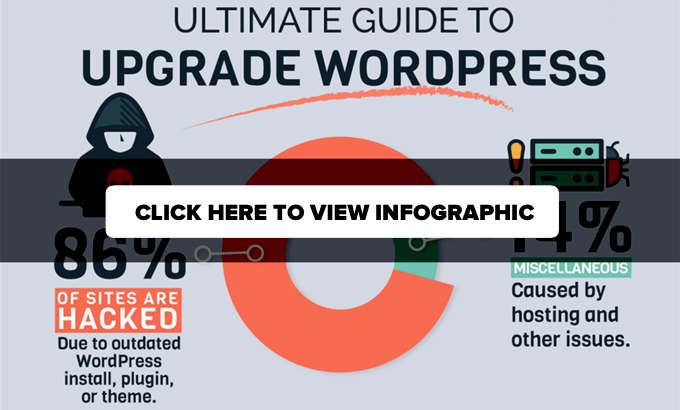
Why Should You Always Update WordPress?
Leading WordPress security research shows that the majority of WordPress websites that get hacked have outdated WordPress core, plugins, or themes.
WordPress is actively maintained by developers from all over the world. These developers find and fix bugs, add new features, and hunt down security vulnerabilities on a regular basis. These changes are then released in a new WordPress version.
If it is not a big release, then WordPress can automatically update itself to the newer version. For major releases, unless you are on managed WordPress hosting, you will have to manually initiate the update process yourself.
You need to update to make sure that your website has the latest security patches, the newest features and functionality, and the best speed and performance.
You can learn more on this important topic in our guide on why you should always use the latest version of WordPress.
💡Need help managing your WordPress site? Let WPBeginner experts handle all WordPress technicalities. Backups, updates, security – we’ve got it covered. We keep your site running smoothly so you can spend your time on what truly matters.
That being said, let’s take a look at how to safely update WordPress to the latest version.
Things to Do Before Updating WordPress
The most important thing you need to do before upgrading WordPress is to create a complete WordPress backup.
Even if you have an automated WordPress backup plugin set up like Duplicator, you still need to create a new backup and store it safely in a remote location, such as your computer or cloud storage like Google Drive.
A complete WordPress backup includes everything:
- Your WordPress database
- All your images and media uploads
- Your WordPress plugins and themes
- Your WordPress configuration files
- Core WordPress files
This step is crucial as it will allow you to restore WordPress from the backup in case something goes wrong.
Once you have created a complete backup and stored it remotely, then you can move on to the next step.
Updating WordPress to the Latest Version
There are two easy ways to upgrade your WordPress site to the latest version. One is automatic, and the other one is manual. We will show you both of them.
Method 1: Updating WordPress Using the Built-in System (1-Click)
This method is easier and is recommended for all users.
First, log in to the admin area of your WordPress website and go to the Dashboard » Updates page.
You will see the notice that a new version of WordPress is available. Now, you just need to click on the ‘Update to version X.X.X’ button to initiate the upgrade.
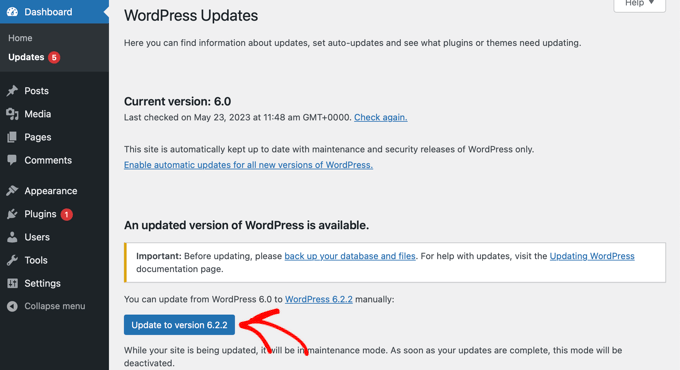
WordPress will now fetch the latest version of the software and install it for you.
You will see the update progress on your screen. During the upgrade, WordPress will put your site into maintenance mode.
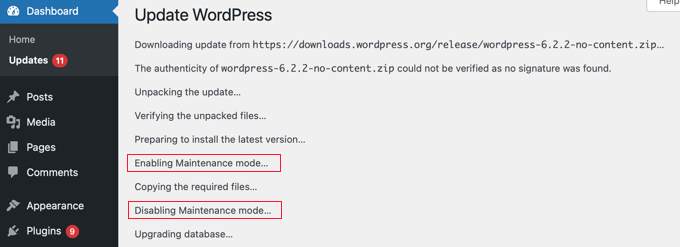
Your site will still be visible to users, but you can’t install plugins or themes while the update is underway.
Once the update is over, you will be redirected to the WordPress welcome screen. Depending on each release, you may see a page explaining what’s new in WordPress and the features you should try.
That’s all; you have successfully upgraded WordPress to the latest version.
Method 2: Manually Update WordPress Using FTP
This method requires you to use FTP to manually upload WordPress files. You can use this if the first method doesn’t work.
First, you will need to download the latest version of WordPress. Head over to the WordPress download page and click on the ‘Download’ button.
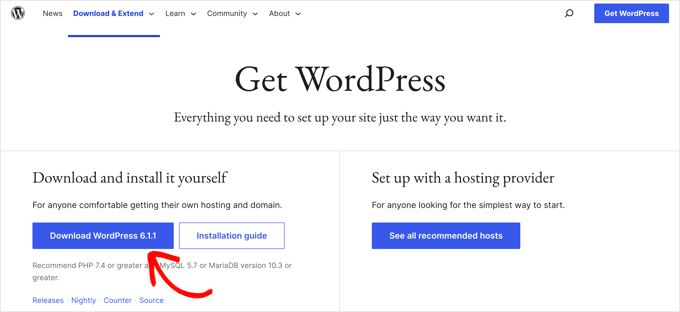
Your browser will now download WordPress in a zip file. Once downloaded, you need to extract the zip file.
Inside, you will see a wordpress folder. This folder contains all the WordPress files you need for the update.
Next, you need to open your FTP client and connect to your website. Once connected, go to the wordpress folder you just extracted from the zip file in the local files column.
In the remote files column, go to your website’s root folder. This folder could be public_html or named after your website’s domain name. Inside this folder, you will see your WordPress files and folders.
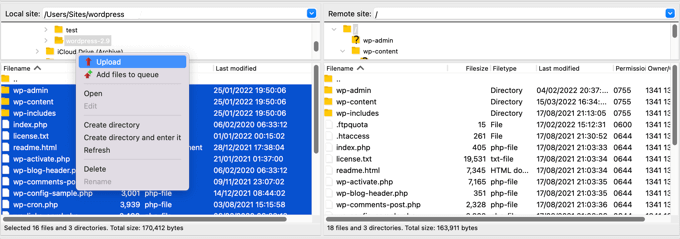
You should select all files inside the wordpress folder on your computer and then right-click to select ‘Upload’.
Your FTP client will now start uploading WordPress files from your computer to your website.
However, your website already has older versions of the files with the same name. You will be asked what you want to do with those files. You need to select ‘Overwrite’ and check the box next to ‘Always use this action’.
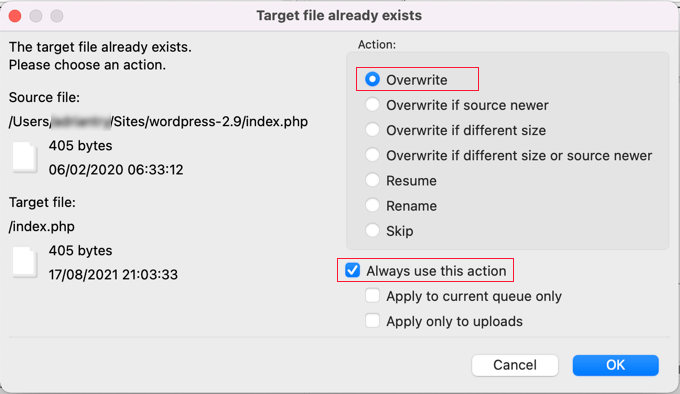
This will ensure that all WordPress files on your website are replaced by the newer versions.
Once the upload is finished, you need to go to your WordPress dashboard. This step is necessary because sometimes, a newer version of WordPress may also need to update your WordPress database.
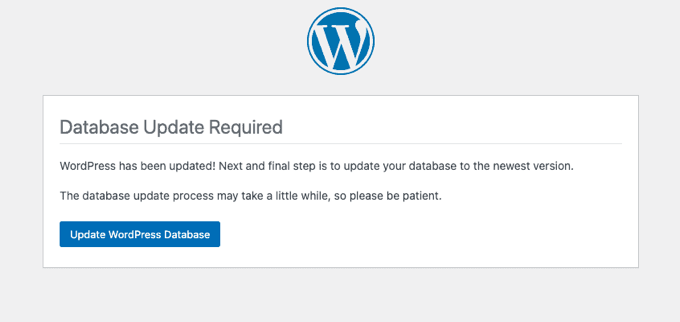
In that case, you may see a page mentioning that a database update is required. Simply click the ‘Update WordPress Database’ button to continue.
That’s all. You have successfully updated your WordPress website.
Things to Do After Updating WordPress
Once you have upgraded WordPress on your website, you need to make sure that everything is working as expected. Simply visit your website in a new browser window and review the settings in the WordPress admin area.
If you come across any compatibility issues, then take a look at our list of common WordPress errors and how to fix them. If the issue you are facing is not listed there, then follow the steps in our WordPress troubleshooting guide to figure out the problem and apply a solution.
Expert Guides Related to WordPress Updates
We hope this article helped you update WordPress to the latest version. You may also want to see some other WordPress tutorials related to updates:
- Why You Should Always Use the Latest Version of WordPress
- Should I Update WordPress or Plugins First? (Proper Update Order)
- How to Check and Update to the Latest WordPress Version
- How to Check for WordPress Security Updates (Beginners Guide)
- How to Use WordPress Recovery Mode
- How to Better Manage Automatic WordPress Updates
- How to Enable Automatic Updates in WordPress for Major Versions
- How to Disable Automatic Updates in WordPress
If you liked this article, then please subscribe to our YouTube Channel for WordPress video tutorials. You can also find us on Twitter and Facebook.





Samuel
This is a fantastic article on how to update WordPress site and the infographic is a beautiful guide in steps to follow in update any WordPress site. However, I like to add that, when you backup for the purpose updating your WordPress website, it is essential to test your backup, perhaps on a local server to make sure the backup is done correctly and that nothing breaks in it. You don’t want to finish updating WordPress and run into issue, then you decide to roll back to the previous version of your website only to find out that your most recent backup is broken. Great article, as always. Thank you so much WpBeginner.
Nicolau Nicoleta Mihaela
Thank you, team!
WPBeginner Comments
You’re welcome!
SF
My wordpress update is stuck at 4,7 version, it is showing me that is a new update for 6 version, but after I push the upgrade button for this new version 6 the page is turning back with version 4.7. What can I do?
WPBeginner Comments
As always we recommend making a full site backup before updating.
In this case, it could be that the PHP version also needs to be updated. We recommend checking out this guide: https://www.wpbeginner.com/wp-tutorials/how-to-update-your-php-version-in-wordpress-the-right-way/
Also, we recommend reaching out to your hosting provider’s support team if possible.
Jiří Vaněk
Great analysis on how to update WordPress. Personally, I prefer manual updates because I usually have more complex websites and I’m afraid that automatic updates might break the site. Of course, I always regularly back up using automatic backups with Duplicator. It will be interesting to see what a game-changer WordPress version 6.6 will be, where automatic backups are improved with a rollback to the previous version if an issue arises during an update. I think this could solve many problems that occur after updates. But we’ll see if this feature will be as good as everyone expects.
Mrteesurez
I totally agree with your approach to manual updates. I’ve found that to updates manually allows for better control and troubleshooting if something goes wrong. Although it does require more time and attention, but it’s worth it for the peace of mind. I always keep a close eye on my sites during updates to avoid any unexpected downtime.
mohadese esmaeeli
I am a bit confused about which updating method is better, and I want to know whether to enable the automatic WordPress update feature or manually update WordPress ourselves. Alternatively, is it safer to update the WordPress core through the hosting service? Which method is more secure?
WPBeginner Support
It would depend on which you prefer using for which is best. Using a service from your hosting provider is not inherently safer unless they have a support guarantee in which case they may help you should you run into an error.
Admin
mohadese esmaeeli
Hello! In the security enhancement article that you have published, I learned that it is better to enable the automatic update feature for WordPress. However, sometimes issues arise after automatic updates. How can we prevent or troubleshoot these problems?
WPBeginner Support
For troubleshooting we do have a guide to help with general troubleshooting below, for preventing the errors that is normally done from the developer of the plugin’s side. Errors are not expected normally so if you run into one it is normally not expected.
https://www.wpbeginner.com/beginners-guide/beginners-guide-to-troubleshooting-wordpress-errors-step-by-step/
Admin
Jiří Vaněk
It depends on how complex your website is. How large it is and how many plugins you use. Generally, in my practice, if the website is small, with up to ten plugins, I don’t have a problem with automatic updates. However, if I have a more complex website with many plugins and posts, I am very cautious and perform updates manually. As for defense, the best practice is to regularly update so you can always revert back if needed. Having backups always on hand is probably the safest practice.
Ralph
I always keep my WordPress up-to-date. I don’t upgrade right away as I’m afraid of some bugs or errors, and I wait 3 to 5 days. I just update it in the dashboard and have never had any problems in over 10 years, but just in case, I have backups made on hosting and with a plugin.
Moinuddin waheed
This is one of the pressing issues for beginner wordpress user because it seems that updating will change everything and will affect the visual appearance of the website.
I have faced the same issue multiple times and have not updated for this reason only.
Thanks for clearing everything about updating wordpress to the latest version.
WPBeginner Support
You’re welcome and as long as there is no issues with the theme you are using, there should be no visual changes when you update your WordPress site.
Admin
Unarine Leo Netshifhefhe
Is it possible that by updating WordPress it increases chances of me being hacked? Like few hours after updating it, my website just started acting up and then was hacked,or maybe it was another reason?
WPBeginner Support
It is extremely unlikely that updating WordPress would cause your site to be more likely to be hacked. We would recommend taking a look at our guide below for steps you can take to help secure a site and prevent the other ways it could have been compromised.
https://www.wpbeginner.com/wordpress-security/
Admin
Kevin Harper
When uploading via FTP I get a “write permission denied” error for all files?
WPBeginner Support
You would likely want to check with your host’s support to ensure you have the correct permissions for your FTP user
Admin
Denis
Hi there,
One question, if we are using the FTP manual Wordpress update, should we overwrite the wp-content folder of our existing site?
I am afraid it will overwrite all existing Theme, Plugins with the new Wordpress wp-content default folder.
Thx for checking your instructions.
Denis
WPBeginner Support
You would copy that over as well, it should not overwrite your theme and plugins as those are not a part of the default WordPress files.
Admin
Mike
Where can I find out information on just what is included in upgrade package. Also does an upgrade include all of the websites I manage?
WPBeginner Support
Hi Mike,
WordPress updates are for the WordPress core software. Plugins and themes release their own updates.
Admin
Diana
I hate to ask the most obvious questions but the flow chart starts with “start wordpress update” where do I go in my admin section to actually find the updates? All I can find is the upgrade section which seems to be different.
WPBeginner Support
Go to WordPress admin area. In the left sidebar you will see Dashboard icon clicking on it will display Updates menu under it. WordPress will also notify you when there is a new version available for you to download and install. You can also access the update page directly by accessing the url:
http://www.example.com/wp-admin/update-core.phpDon’t forget to replace example.com with your own domain name.
Admin
Nicole
Does this only apply to wordpress.org blogs?
WPBeginner Support
yes it applies to self-hosted WordPress sites only.
Admin
Jim Walker
While upgrades are important, certainly no harm in waiting a few days.
None of the security issues are life threatening.
Never a bad idea to let others do the beta testing first… Stay frosty!
clippingimages
WoW Awesome article. Thanks for sharing this nice post.
Awesome article. Thanks for sharing this nice post.
Tina
This is a nice guide, but it’s the UPGRADE step that intimidates me! I look at the instructions on wordpress.org and I tense up, scared. Is there an easy “how to upgrade” guide anywhere for people like me?
Editorial Staff
You follow the directions in this infograph and click on Upgrade Now button in your WP-Admin panel.
Admin
Roger Duck
Updating is critical for WordPress users who want to avoid the inevitable. Hackers are searching out older versions of WordPress for the exploit vulnerabilities widely publicized. Follow this guide to lock down your WordPress site now.
Alexander
I completely agree. I keep my blog up to date, both the plugins and the WordPress built.